Conures are a diverse, loosely-defined group of
medium-sized to small
New World parrots. Essentially they are large parakeets
native to Central and South America. For parrots, conures are lightly built,
with long tails (Conure literally means 'cone tail') and
small, strong beaks. They have a diverse range of colors.
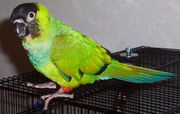
Nanday Conure
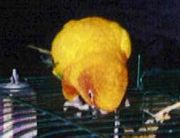
a Sun Conure
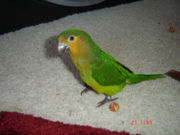
a rare St. Thomas Conure
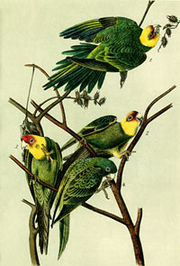
Extinct
Carolina parakeet
Description
Conures are either large parakeets or small parrots that
are found in the western hemisphere. They are analogous in size and way
of life to the
Old World's
Rose-ringed Parakeets or the
Australian parakeets. All living conure species are found in
Central and South America; the extinct Conuropsis
carolinensis or Carolina Parakeet was an exception.
Despite being large for parakeets, conures are lightly
built with long tails and small (but strong) beaks. Conure
beaks always have a small cere and are usually horn-colored
or black. Most conure species live in flocks of 20 or more
birds. Conures often eat grain, which causes them to be
treated as agricultural pests in some places.
Conures are as diverse a group as
African Parrots, so trying to characterize them all is
difficult and inaccurate. The category conure is
loosely-defined because they do not currently constitute a
natural, scientific grouping. The
macaws are so closely related to conures that strictly
by descent,
macaws could also be called "conures". The term
conure is now used mostly in
aviculture. Scientists and laypeople alike tend to refer
to these birds as "parrots" or "parakeets." (See below
under
Scientific Classification for more details.)
Conure Species
Conures, as the term is used by aviculturists, include
only the genera Aratinga and Pyrrhura, as well as several single-species genera
and one double-species genus*. These other genera are listed
below:
- Conuropsis:
Carolina Parakeet (extinct)
- Cyanoliseus: Patagonian Conure
- Enicognathus: Austral and Slender-Billed
Conures
- Guarouba: Golden or Queen Of Bavaria Conure
- Leptosittaca: Golden-Plumed Conure
- Nandayus: Nanday Conure
- Ognorhynchus: Yellow-Eared Conure
Aratinga
Latin for "little macaw," (ara - macaw, tinga -
diminutive) the Aratinga conures generally seem to have a
more mischievous personality than the real little macaws or
mini macaws. The Aratinga conures are generally larger with
brighter plumage and are generally the noisier, more
outgoing, more demanding of the two primary conure genera.
The Sun Conure and Jenday Conure are among the species of conures more
commonly kept as pets.
Pyrrhura
Pyrrhura is the other large genus of conures. These
generally greenish conures including the very common
Green-cheeked Conure. Usually smaller, duller-colored, and
quieter than the Aratinga conures, the Pyrrhura conures
contain almost every conure species with a hyphen in the name, and the majority of Pyrrhura
species names are hyphenated.
Nanday Conure
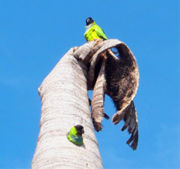
Pair of wild Nanday Conures
The Nanday conure, Nandayus nenday is the
most commonly kept pet conure species outside of the two
main genera. Some experts believe that Nandays should
actually be grouped with the Aratinga genus, since they are
cross-fertile with such species as Jendays and Suns. Nanday
conures have a distinctive black head, and wings and tails
tipped with dark blue feathers. They have a light-blue scarf
and bright orange feathers on their legs and around their
vents. The maturity of a Nanday can be told by the edges of
its black hood: if the hood has a ragged edge of brown, then
the bird is over a year old. Although Nandays are often said
to be extremely noisy, it might be more accurate to say that
they are a heavily flock-oriented species, used to making
their demands known, calling out warnings for the group, and
making inquiries about other members of the group who are
out of sight. They are also extremely intelligent birds,
capable of learning tricks, mimicking sounds, and learning a
small vocabulary. At least one report suggests that they are
highly adaptable to human encroachment on their territories,
but the exact status of the species in the wild is unknown.
Golden Conure
The Golden conure or Queen of Bavaria Conure,
Guarouba guarouba (recently reclassified from
Aratinga guarouba) is, as the name implies, covered all
over with bright yellow feathers, except for the green
wing-tip feathers and the greyish-horn-colored beak. Golden
conures are among the most expensive conures both to
purchase and to care for, although many owners feel that the
benefits outweigh the cost. It is one of the rarest Conures
in the wild in addition to the pet trade. Many experts
believe that these birds should not be kept in captivity
unless in a breeding program.
Patagonian Conure
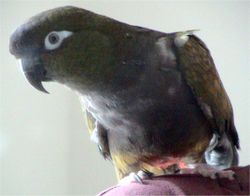
Patagonian conure, Cyanoliseus patagonus
The Patagonian conure, Cyanoliseus patagonus,
is a large conure found in the Patagonia region of
south-central Argentina and Chile. Drab on the top, brighly
colored underneath, the Patagonian conure has exploded in
popularity since the 1990s, leading to an increase in illegal importation
which threatens the wild populations. It is also known as
the "burrowing parrot," due to its habit of nesting in holes
in the ground. Unsurprisingly, Patagonians in captivity are
great chewers, and have been known to munch through
furniture and even walls.
Enicognathus
The dusky red-tailed and green Austral conure and
the descriptively named Slender-billed conure make up
the genus Enicognathus. Although both birds in the
genus are available in aviculture, neither is especially
common in captivity.
Golden-Plumed Conure
The Golden-plumed conure, Leptosittaca
branickii, is a small Andean conure not found in
aviculture and endangered in its own habitat.
Yellow-Eared Conure
The exceedingly rare Yellow-eared conure or
Ognorhynchus icterotis of
Colombia and Ecuador was never common in aviculture and has not
successfully bred in captivity.
Carolina Parakeet
Conuropsis carolinensis, the
Carolina Parakeet, was the only parrot species
indigenous to the United States. The Carolina parakeet was a
remarkably social bird, living in vast flocks. American bird
hunters reported that Carolina Parakeets would return to
mourn dead members of the flock, making themselves easy
targets. Considered a pest, popular in the pet trade, and
bearing plumes feathers valued for hats, this species was
hunted to extinction around the beginning of the 1900's.
Scientific Classification
The word conure is an old term and was originally
used as a descriptive name for the members of the
nolonger-used genus Conurus, which included the
members of Aratinga and Pyrrhura.
The parrot order
Psittaciformes is a rather confusing tangle of genera, many
containing only one species. Parrots or Psittacines (order
Psittaciformes) includes about 353 species of bird which are
generally grouped into two families: the Cacatuidae or
cockatoos, and the Psittacidae or true parrots. The term parrot is
generally used for both the entire order as well as for the Psittacidae alone.
All members of the Psittaciformes order have a
characteristic curved beak shape with the upper mandible
having slight mobility in the joint with the skull and a
generally erect stance. All parrots are zygodactyl, having
the four toes on each foot placed two at the front and two
back.
The conures and all other New World parrots are often
placed in a subfamily or tribe Arinae. Internal
relationships of conures are poorly understood though it
seems evident that, to make them a natural grouping, the
Quaker parakeet1, the thick-billed parrot, and Brotogeris2
should be included, and often are. Neotropical parakeets,
macaws, and other are also candidates potential for
inclusion. In this scheme, "conure" would comprise members
of the genera:
- Aratinga
- Pyrrhura
- Nandayus
- Guarouba
- Cyanoliseus
- Enicognathus
- Leptosittaca
- Ognorhynchus
- Conuropsis
- Rhynchopsitta: Thick-billed parrot
- Myopsitta: Quaker parakeet
Macaws:
-
Ara
- Anodorhynchus
- Cyanopsitta
- Diopsittaca
- Orthopsittaca
- Primolius
In addition the
caiques and the hawk-headed parakeets have also been proposed for
inclusion. Both the caiques and the Hawk-headed parakeets
have a heavier build and different tail structure from
traditional conures.
1The Quaker or
Monk parakeet is technically a conure by almost
anybody's definition, but due to its popularity in
aviculture and its uniqueness, it is generally considered in
a category of its own. 2Brotogeris are not
only often counted as conures, but as
parrotlets as well, and it is not clear precisely which
one, or both, or neither, they belong to. Certainly the tail
structure is different from that of the parrotlets, although
the basic body structure seems to be analogous with both
groups.




